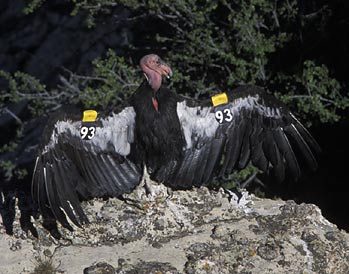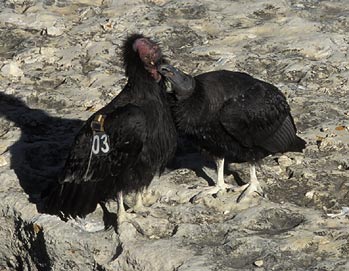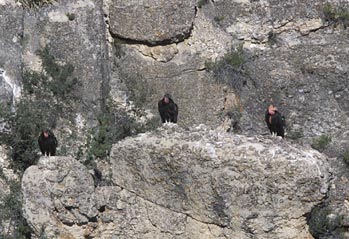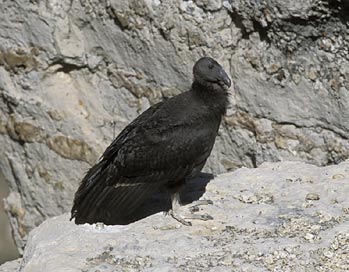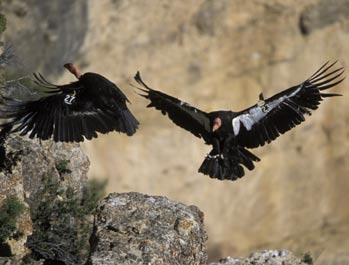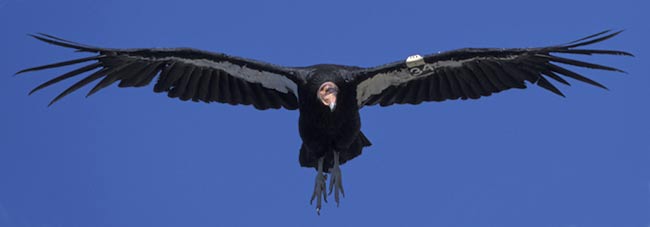On the brink of extinction with a population low of only 22 individuals in 1982, California Condors are making a comeback. Following the controversial capture of all wild individuals and a vigorous captive breeding program, reintroductions of California Condors began in California in 1992 and in Arizona in 1996. Reintroductions are continuing and now include Baja California as well.
With a wingspan of up to 9.5 feet, the California Condor is a magnificent soaring bird. Strict scavengers, they can cover large areas in search of food without expending a lot of energy. Adults can readily be identified by the triangular white area on the underside of each wing and a pink-orange, featherless head. Condors attain adult plumage and coloration when they reach sexual maturity at 5-6 years of age. Immatures have mottled white triangular wing patches and a dusky black, featherless head. Numbered wing tags are attached to all released condors. More information on the California Condor reintroduction can be found at www.peregrinefund.org. Photos were taken at the Grand Canyon and Vermilion Cliffs in northern Arizona.
 |
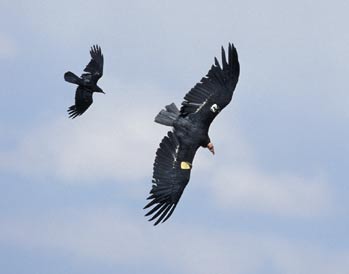 |
| Immature condor on the left and adult on the right. California Condors are very social birds. An immature with an adult does not necessarily mean that they are related. The adult has recently fed as evidenced by the distended crop, the pink area on the breast. |
This Common Raven chasing a California Condor gives an idea of the size of condors. Ravens frequently harass condors in the air and on the ground. |
| Condors spend time "sunning" both in the early morning and late afternoon. They will both face the sun and face away from the sun with their wings extended. |
Mutual preening, also known as allopreening, is a common behavior with condors. The individuals are not necessarily related. Each wing is fitted with a numbered tag and a radio transmitter. |
| California Condor #253 landing on a rock column. When not searching for food condors spend much of the day preening and sunning. They spend nights high on cliff ledges inaccessible to most predators. |
California Condors often perch at the edge of a rock column or on a high ledge. When they want to take flight they just spread their wings and drop off the edge. |
| California Condor #305, the first successful wild-reared condor since the reintroduction began. The egg was laid in March 2003 and it fledged in November 2003. Wing tags and radio transmitters were attached after it was trapped. |
The parents of California Condor #305. The female #123 is forcing the male #127 from his rock perch. The nest was in a cave in the rock formation known as the Battleship in Grand Canyon National Park, AZ. Incubation lasted about two months and it took about six months for the nestling to leave the nest. The fledgling will continue to be fed by the parents for a year or more. |
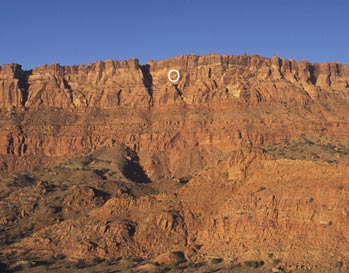 |
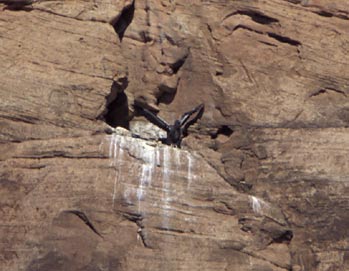 |
| A California Condor nest cave was located high on the face of the Vermilion Cliffs in 2004. The white circle gives the approximate location. The parents were male #122 and female #149. The egg was laid in March and hatched in May. |
A closer view of the Vermilion Cliffs nest cave with condor nestling #342 flapping its wings at the entrance. This photo was taken in early October 2004 and the nestling successfully fledged about a month later in November 2004. |




